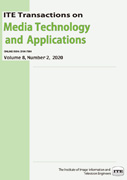Volume 8, Issue 2
Displaying 1-6 of 6 articles from this issue
- |<
- <
- 1
- >
- >|
Special Section on Sports Information Processing Technology and Its Application
-
2020Volume 8Issue 2 Pages 69
Published: 2020
Released on J-STAGE: April 01, 2020
Download PDF (408K) -
2020Volume 8Issue 2 Pages 70-80
Published: 2020
Released on J-STAGE: April 01, 2020
Download PDF (6808K) -
2020Volume 8Issue 2 Pages 81-88
Published: 2020
Released on J-STAGE: April 01, 2020
Download PDF (4533K) -
2020Volume 8Issue 2 Pages 89-99
Published: 2020
Released on J-STAGE: April 01, 2020
Download PDF (2477K) -
2020Volume 8Issue 2 Pages 100-110
Published: 2020
Released on J-STAGE: April 01, 2020
Download PDF (2093K)
Regular Section
-
2020Volume 8Issue 2 Pages 111-124
Published: 2020
Released on J-STAGE: April 01, 2020
Download PDF (2625K)
- |<
- <
- 1
- >
- >|
